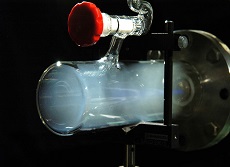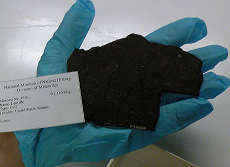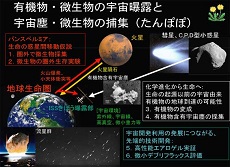Subject of Research
A. Origins of life
Life is considered to have been originated in the primitive ocean about 3.8 billion years ago. As places for evolution of organic matter toward the origin of life, we are conducting model experiments such as primitive atmosphere, space, and primitive ocean, and verifying under what conditions, and what molecule or biochemical function can be formed.
a) Synthesis and analysis of biological molecules in simulated primitive Earth environment
We irradiate various energy (radiation, ultraviolet rays, discharge of electricity, etc.)
to simulated primitive Earth atmosphere, and then analyze the formation matter using mass spectrometer and chromatography.
In these experiments, abiotic formations of bioorganic compounds, such as amino acids, nucleic acid bases, and sugars
has been studied.
In order to examine chemical evolution in Titan (Saturn's satellite), which is also noted as a model of primitive Earth,
we give various energy to simulated Titan atmosphere (nitrogen and methane) and analyze reaction products.
Furthermore, formation and alteration of organic compounds such as amino acids have been investigated
with a test device simulating submarine hydrothermal environment (supercritical water flow reactor) noted as a place for emergence of life .
b) Analyses and syntheses of organic matter in simulated space environments

Organic matter in comets and meteorites is considered to have played
an important role in origins of terrestrial life. These organic compounds may have formed on interstellar dust grains in molecular clouds.
Therefore, possibility of organic formation in outer space is examined by irradiating ultraviolet rays,
proton, and heavy ion beam to ices simulated interstellar dust.
It is pointed that the asymmetry of biomolecules such as amino acids might have caused by space environments.
To test this hypothesis, we irradiate circularly polarized ultraviolet rays on 'simulated interstellar organic matter',
and analyze chirality of the formation products with HPLC, GC/MS, circular dichroism (CD) spectra and so on. FT-IR,
mass spectrometry, and X-ray spectroscopy (XANES) are also used to analyze the formation products.
Moreover, asteroids, parent bodies of meteorites, can be places for organic matter formation, we examine what organic compounds were formed in the aqueous alteration process by simulated experiments.
c) Analyses of organic matter in extraterrestrial samples

Extraterrestrial materials, especially meteorites called carbonaceous chondrites
contain various organic matters. We analyze trace amino acids in the meteorites and develop
analytical methods for it.
The majority of organic matter in meteorites are complex macromolecular organics
called insoluble organic matter (IOM). The molecular structures of IOM reflect their degree of aqueous alteration or
thermal metamorphism in asteroids, their parent bodies. We investigate how they formed and evolved using FT-IR,
X-ray spectroscopy (XANES), and mass spectrometry.

Subject of Research
B. Distribution of life
d) Research on detection method of microbial activities under extreme environments within or out of the Earth environment
Since microbial activities have detected in underground rocks, under hydrothermal environment,
and in upper atmosphere, biosphere of the Earth is found to indicate larger extent than we have ever thought.
However, analytical methods to investigate the extent of biosphere have not been established yet.
We study analytical methods of microbial activities on and out of the Earth focusing on amino acids and their D/L ratios
or on enzymic activities.
These new methods are examined with samples from extreme environment such as Antarctic soils and ices,
rocks in the submarine hydrothermal environment, and desert soils to detect novel biosphere.
Based on these results, future search for extraterrestrial life on Mars or other is investigated.
Objective of Lab

1) Graduate School of Engineering
Most students learn methods and techniques during their study for graduation, then apply those techniques to various themes of Astrobiology in their master's course. This is the reason why we encourage university students to go on to graduate school.
2) Career of Students
Students graduated with master's degree find work in companies, such as Toyota,
Nissan Motor Co., Suntory, Asahi Glass, Mitsubishi Plastics, Kyowa Hakko and Nippon Oil Corporation,
with analytical techniques acquired in our lab.
Doctoral graduates (currently 12 graduates) take an important role in various fields such as Tokyo University of Science,
Japan Agency for Marine-Earth Science and Technology (JAMSTEC), and Agilent Technologies.
3) Joint Research with Other Laboratories
Students who are fond of experiments, full of curiosity, and have an unflinching spirit are welcomed,
as our research requires using large facilities in other institutes and joint research with laboratories
both at home and abroad.
We often use large equipment such as heavy particle accelerator detector 'HIMAC' (National Institute of radiological Sciences),
tandem accelerator (Tokyo Institute of Technology), synchrotron radiation (New SUBARU of University of Hyogo and others),
and two-stage light gas gun (JAXA).
We also promote exchange and joint research with institutes abroad,
including Strasbourg University (France), National Autonomous University of Mexico, and NASA (U.S.A.).
4) Presentations
Since students are strongly encouraged to have a presentation at a conference either domestic or abroad. More than 50 presentations are performed every year. At least one oral presentation per year is required for students in master's or doctor's course. Participations in various meetings and workshops are also encouraged. We want our students to study voluntarily on their original field.
